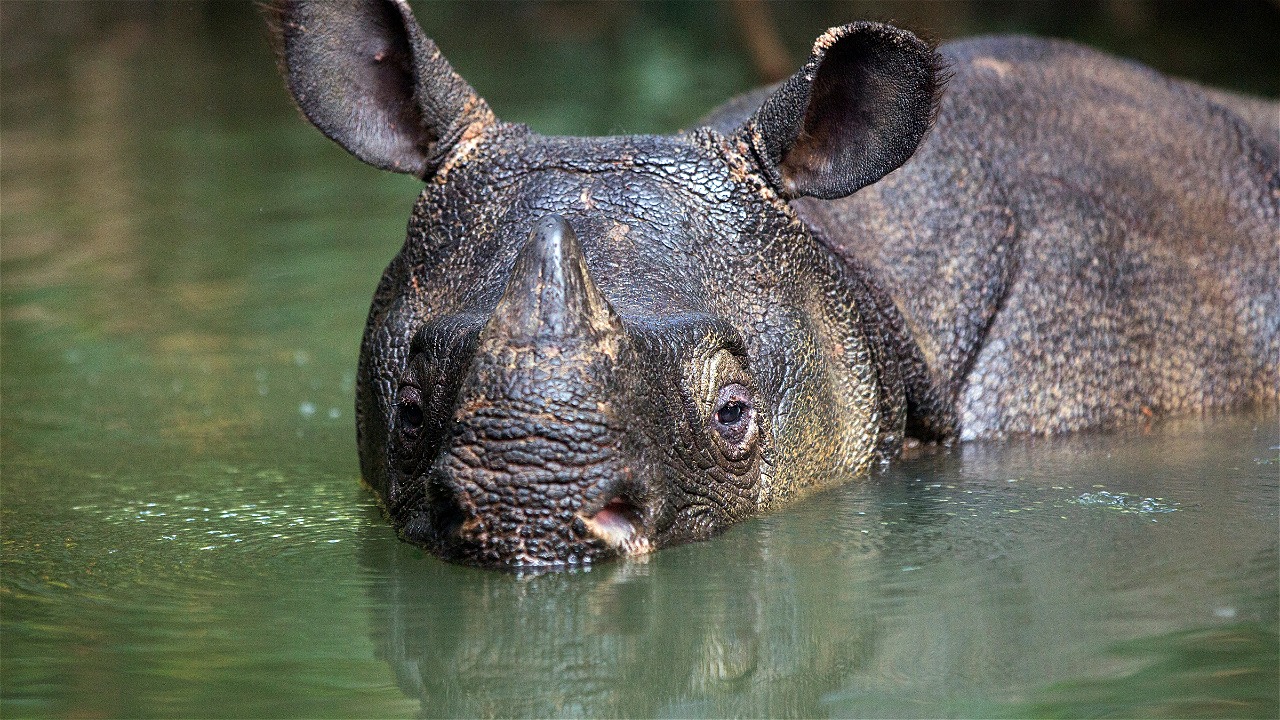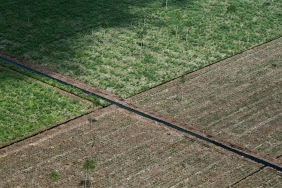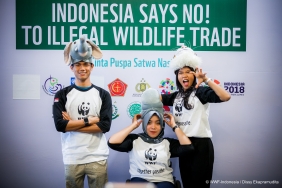TRACING THE FOOTSTEPS OF A ONE-HORNED RHINO ON THE WESTERN TIP OF JAVA ISLAND
By: Natalia Trita Agnika
Two canoes made their way down the Cigenter River in silence punctuated by chirping birds. About 20 people enthusiastically looked at the trees surrounding the river and were occasionally surprised by the appearance of batik pythons and civets in the shade of the trees. They are the winners of the writing competition ""How is a Comfortable Home for Rhinos? " organized by WWF-Indonesia and VIVA.co.id. The winners are Gigin Ginanjar, Rifqi R. Hidayatullah, Dzamaru, Ari Supriadi, Nipal Sutiana, and Dwi Bayu. Accompanied by WWF-Indonesia staff of Ujung Kulon office and employees of Ujung Kulon National Park (TNUK), they traced the tracks of Javan rhinos (Rhinoceros sondaicus) in Ujung Kulon for three days and two nights on November 9-11, 2015.
Entering the transect 8 area, the group got off the canoe and entered the dense forest. Ade Sumarna, a member of TNUK's Rhino Monitoring Unit, led the way. As a member of the Rhino Monitoring Unit, going in and out of the forest to monitor the presence of Javan rhinos has become part of his daily activities. The group of journalists and bloggers were then invited to see rhino wallowing places, observe horn scratches on tree trunks, observe rhino feces from close range, and see the rhinos' "restaurant" which is overgrown with plants that are the rhinos' favorite food. Currently, the threat to rhino food is increasing as the langkap (Arenga obtusifolia) plant thrives in the forest. ""This langkap blocks sunlight so that rhino food plants cannot grow,"" explained Ade while pointing to a palm-like plant. In response to this problem, WWF-Indonesia developed a project to control the growth of langkap. Ade also explained how to install a camera trap (camera trap) used to observe Javan rhinos.
In addition to going directly to the field to trace the tracks of the Javan rhino, the group also received explanations from WWF-Indonesia staff and the Head of the TNUK Center regarding the management of the TNUK area as a habitat for Javan rhinos and the ins and outs of Javan rhino conservation in TNUK. The Head of TNUK, M. Haryono revealed that from the results of monitoring in 2015, there were 60 Javan rhino individuals. M. Haryono also explained the importance of second habitat in Javan rhino conservation. "Rhinos in one population are at risk of extinction due to disease or natural disasters. Therefore, it is necessary to build new hope outside the Ujung Kulon peninsula," he explained. This second habitat is also to avoid inbreeding which will result in a decrease in genetic quality and the species becomes vulnerable to disease.
Not only learning about "Habitat and Population Management of Javan Rhinos", the media trip group also visited the Ecotourism Village of the Paniis Lestari Group, Taman Jaya Village, Sumur District, Ujung Kulon. They stayed at a resident's house that functions as a homestay when there are tourist visits. The group, assisted by WWF-Indonesia since 2006, offers cultural tourism, nature tourism, and marine tourism. The group was treated to Lesung Dance and Rengkong Dance performed by the locals. Both dances are symbols of gratitude to the earth for providing various natural products. Usually this dance is performed before the rice planting period.
The Paniis Lestari group also cultivates soft corals on Badul Island. The group was invited to see the coral planting location and had the opportunity to plant corals directly. "This coral planting is in accordance with our motto, No Coral No Fish," explained Doni, chairman of the Paniis Lestari Group. "Over time, coral rehabilitation activities on Badul Island also provide economic benefits for the Paniis Lestari Group. They also conduct coral reef patrols and monitoring activities and provide mooring for boats going to Badul so that they don't drop anchor," explained Andri, WWF-Indonesia's Coastal and Ecotourism Officer at Ujung Kulon.
The series of activities on the western tip of Java Island was closed by visiting the Ciwisata (Cinibung Wisata) Group in Kertajaya Village, Sumur District, Pandeglang Regency. In this place, the group had the opportunity to participate in learning to make rhino statues from wood. Members of the Ciwisata group crafted rhino statues from leftover wood waste from building materials. Some of the statues are also decorated with batik patterns. This side business carried out by a group that received assistance from WWF-Indonesia is one of the efforts to prevent disturbance to flora and fauna in the TNUK area.
bloggers and journalists at WWF-Indonesia's office in Ujung Kulon.





